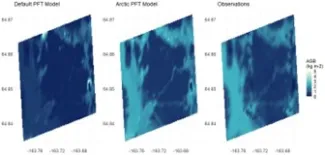Incorporation of diverse arctic vegetation types in a land surface model improves representation of spatial variability in carbon dynamics and net site-level budgets across a tundra landscape.
Model predictions of climate change in arctic regions are highly uncertain, partly due to challenges in capturing the complexity of arctic ecosystems and the historically limited availability of data for model validation and calibration. Arctic ecosystems are typically represented in a simplified manner; for instance, the Energy, Exascale Earth System Model (E3SM) divides arctic vegetation into two plant functional types (PFTs): deciduous shrubs or grasses. Recent efforts have integrated nine diverse arctic PFTs into the E3SM land surface model (ELM), leveraging data from NGEE Arctic to parameterize the additional PFTs. These changes included enhanced belowground biomass allocation and persistent fine roots and rhizomes of nonwoody plants. Here, we combined the new PFTs with plant community mapping to conduct spatially explicit, 100-m resolution simulations at the Council study site on Alaska’s Seward Peninsula. We compared model predictions to observations from three unique data streams: an eddy covariance flux tower, airborne hyperspectral remote sensing, and machine learning-based estimates of biomass derived from canopy height. Model-data comparisons revealed that the refined PFT representation produced more realistic spatial patterns and total site budgets of tundra vegetation biomass and land-atmosphere exchanges compared to the original model. Variability in vegetation biomass and productivity across the tundra landscape was considerably higher when incorporating multiple tundra plant growth forms. Our results demonstrate that enhanced model representation of the diversity of arctic vegetation can provide a more robust predictive understanding of carbon dynamics across tundra landscapes, facilitating regional to pan-Arctic scaling.
Contacts & email addresses: Bailey Murphy (murphyba@ornl.gov); Ben Sulman (sulmanbn@ornl.gov)
Comparison of aboveground biomass (AGB) from ELM simulations with (a) default PFTs and (b) refined arctic PFTs to (c) observations within the Council study site model domain. Site level evaluation of model performance was performed following the International Land Model Benchmarking project (ILAMB) scoring framework, where values closer to one indicate better performance.


